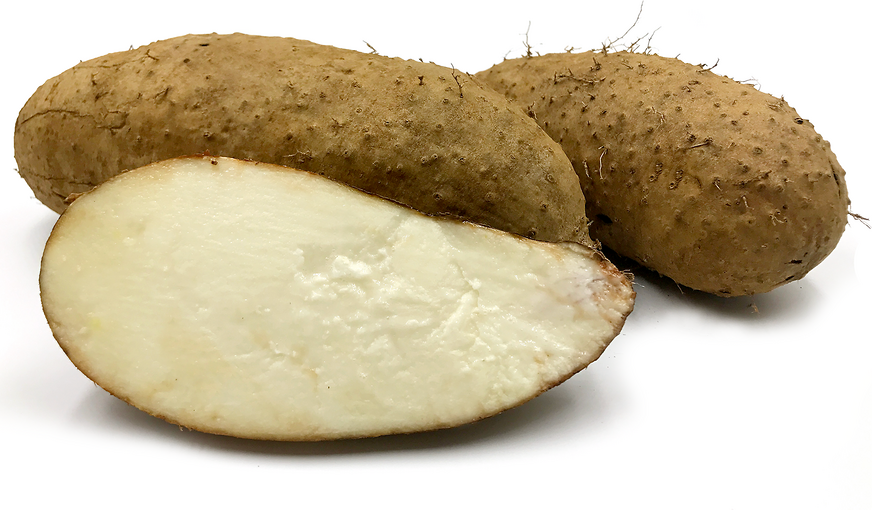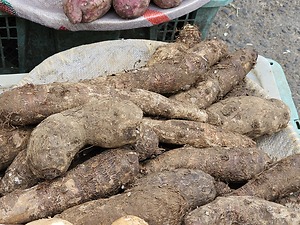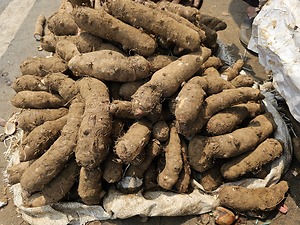


Tugi Root
Estimated Inventory, lb : 0
Description/Taste
Tugi is a small to large tuber, averaging 15 to 20 centimeters in length and 6 to 8 centimeters in diameter, depending on growing conditions, and has a bulbous, slender, and oblong shape with slightly tapered to blunt, curved ends. The tubers range from 250 to 1,000 grams in weight and have thin, rough, textured, pale brown to dark brown skin. The surface is also often covered in tiny root hairs, giving it a hairy, shaggy appearance. Underneath the skin, the flesh is ivory to cream-colored, dense, and starchy. Once cooked, the flesh develops a soft, tender, fluffy, chewy, and thick consistency. Tugi is customarily consumed after cooking and has a nutty, starchy, mild, and sweet flavor. The tubers are generally sweeter than potatoes and have a subtle chestnut-like taste.
Seasons/Availability
Tugi is available in the fall through winter.
Current Facts
Tugi, botanically classified as Dioscorea esculenta, is a tropical species belonging to the Dioscoreaceae family. The tubers develop on a perennial vining plant extending over 2.4 meters in length, and the vines are spiny and climbing, creeping over trees, rocks, walls, and trellises. The vines bear distinct heart-shaped leaves, and each plant can grow anywhere from 20 to 50 tubers per season. Tugi is the name for the species in Tagalog, a language spoken in the Philippines, and the Southeast Asian plant is also known by other names, including Apali, Cheru Kizhangu, Nana Kizhangu, Kaate Kanaga, Potato yam, Lesser yam, Asiatic yam, Siruvalli Kilangu. There are two main types of Tugi, cultivated and wild varieties, and the cultivated plants are grown on a small scale through specialty farms and in home gardens. Tugi is not as widespread as other commercial tubers, but the species has remained a secondary crop valued for its extended storage capabilities, nutritional content, and hardiness. The species is traditionally cooked and consumed in a wide array of sweet and savory preparations.
Nutritional Value
Tugi is a source of calcium to build strong bones and teeth, potassium to balance fluid levels within the body, iron to develop the protein hemoglobin for oxygen transport through the bloodstream, magnesium to control nerve functions, and other nutrients, including zinc, B vitamins, manganese, and other antioxidants. The tubers are known for their anti-inflammatory properties and are topically applied to swellings, boils, rashes, and other skin irritations.
Applications
Tugi has a neutral, mild, subtly sweet, and starchy taste suited for cooked preparations, especially when boiled, roasted, fried, or steamed. The tubers are typically cooked and peeled, revealing a soft flesh popularly dipped in sugar and eaten as a snack. Tugi is also sliced and fried into chips, cooked in methods used to prepare potatoes, or boiled and served with black coffee. In the Philippines, Tugi is cooked in coconut milk or simmered into a vegetable soup known as buridibod or buridibud. This soup has many variations with ingredients such as spinach, winged beans, fried fish, edible flowers, and herbs. Tugi pairs well with aromatics such as garlic, ginger, and onion, tomatoes, moringa leaves, beans, drumsticks, meats including poultry, pork, and beef, and seafood such as fish, shrimp, and clams. Whole, unwashed, and uncooked Tugi will keep for several weeks to months when stored in a cool, dry, and dark place.
Ethnic/Cultural Info
In the Philippines, Tugi is a traditional food served during the annual Fiesta de La Purisima Conception. The celebration is held in Santa Maria in Bulacan on a Thursday in February and features several customary masses and events that Santa Maria residents participate in as a community. Cooked Tugi is one of the most popular items sold through street vendors during this festival and is considered a delicacy. The tubers are delicately stacked in baskets and sold cooked and ready to eat just outside of the town’s central church, also known as La Purisima Concepcion. Local legends throughout the town claim that visions of Saint Mary have been seen walking through the plots of Tugi tubers that are being grown for the festival, and the plants are specifically sown beside villages for the sole purpose of selling during the festival. Tugi is considered a food closely associated with Saint Mary and the cooked tubers are given as an offering at the annual celebration.
Geography/History
Dioscorea esculenta is native to regions of Southeast Asia and has been growing wild in tropical regions since ancient times. Much of the species’ history is unknown, but the tubers were gathered as a food source and were often a choice species as a famine food. Over time, Dioscorea esculenta spread into Southern China in the 2nd or 3rd century and was thought to have been first domesticated during this time. The species was also spread into Oceania and East Africa, but even with expansion, the tubers remained an underutilized crop throughout history compared to other items such as cassava, taro, and sweet potatoes. Today, Tugi thrives in tropical lowland forests up to 900 meters in elevation and is commercially grown on a small scale in select regions as a culinary crop. When in season, Tugi is found in local markets in Southeast Asia, Southern Asia, East Asia, Africa, Hawaii, New Zealand, and Puerto Rico.









